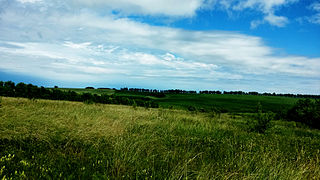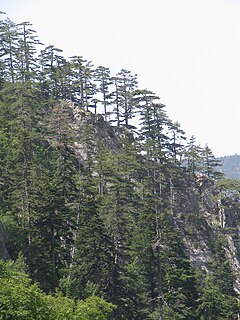 W
WThe Palearctic or Palaearctic is one of the eight biogeographic realms of the Earth. It was first used in the 19th century, and is still in use as the basis for zoogeographic classification. The Palearctic is the largest of the eight realms. It stretches across all of Eurasia north of the foothills of the Himalayas, and North Africa.
 W
WThe Aegean and Western Turkey sclerophyllous and mixed forests is an ecoregion in the lands around the Aegean Sea. The ecoregion covers most of mainland Greece, the Greek Aegean Islands, the western coast of Turkey, the southern Vardar and Struma river valleys in North Macedonia, and the extreme south-western corner of Bulgaria.
 W
WThe Apennine deciduous montane forests are a temperate broadleaf and mixed forests ecoregion in the Apennine Mountains of Italy. The development of these forests is ensured by the high rainfall in the Apennines, combined with a temperate-cool climate. Because of climate change, the presence of silver fir, although still widespread, has been dramatically reduced in favour of beech.
 W
WThe Balkan mixed forests are a terrestrial ecoregion of southeastern Europe according to both the WWF and Digital Map of European Ecological Regions by the European Environment Agency. It belongs in the temperate broadleaf and mixed forests biome and the Palearctic realm.
 W
WThe Baltic mixed forests is an ecoregion in Europe along the southwestern coasts of the Baltic Sea. The name was coined by the European Environment Agency and the same geographical area is designated as "Northern Europe: Germany, Denmark, Sweden, and Poland" ecoregion by the WWF.
 W
WThe Caspian Hyrcanian Mixed Forests ecoregion, in the world's temperate broadleaf and mixed forests biome, is an zone of lush lowland and montane forests covering about 55,000 square kilometres (21,000 sq mi) adjoining the shores of the Caspian Sea of Iran and part of that of Azerbaijan. The forest is named after the ancient region of Hyrcania.
 W
WThe Caucasus mixed forests is a temperate broadleaf and mixed forests ecoregion in the Caucasus Mountains, as well as the adjacent Lesser Caucasus range and the eastern end of the Pontic Mountains.
 W
WCentral Europe contains several life zones, depending on location and elevation.
 W
WThe Central European mixed forests ecoregion is a temperate hardwood forest covering much of northeastern Europe, from Germany to Russia. The area is only about one-third forested, with pressure from human agriculture leaving the rest in a patchwork of traditional pasture, meadows, wetlands. The ecoregion is in the temperate broadleaf and mixed forest biome, and the Palearctic realm, with a Humid Continental climate. It covers 731,154 km2 (282,300 sq mi).
 W
WThe Corsican montane broadleaf and mixed forests ecoregion, in the Mediterranean forests, woodlands, and scrub biome, are on the island of Corsica. The ecoregion includes the high-altitude regions of Corsica's mountain ranges.
 W
WThe Crimean Submediterranean forest complex is an ecoregion on the Black Sea coast of Russia and Ukraine. It is in the temperate broadleaf and mixed forests biome.
 W
WThe Danube Delta is the second largest river delta in Europe, after the Volga Delta, and is the best preserved on the continent. The greater part of the Danube Delta lies in Romania, with a small part in Ukraine. Its approximate surface area is 4,152 km2 (1,603 sq mi), of which 3,446 km2 (1,331 sq mi) is in Romania. With the lagoons of Razim–Sinoe, located south of the main delta, the total area of the Danube Delta is 5,165 km2 (1,994 sq mi). The Razim–Sinoe lagoon complex is geologically and ecologically related to the delta proper and the combined territory is listed as a World Heritage Site.
 W
WThe dinaric calcareous silver fir forests are an endemic vegetation type of the littoral Dinaric Alps, located in the Dinaric Mountains mixed forests ecoregion in southeastern Europe. Pure stands of dinaric calcareous silver fir forests appear on limestone escarpments in the montane zones of Orjen, Velebit, Biokovo and Prenj. They comprise one of the most interesting formations of Balkan vegetation types as the forests bear several rare plants and are of striking beauty. As a highly endemic and rare vegetation type of the dinarids, it needs protection.
 W
WThe Dinaric Mountains mixed forests are a terrestrial ecoregion of the temperate broadleaf and mixed forests biome in Southeastern Europe, according to both the WWF and Digital Map of European Ecological Regions by the European Environment Agency. It also is in the Palearctic realm.
 W
WThe East European forest steppe ecoregion is a patchwork of broadleaf forest stands and grasslands (steppe) that stretches 2,100 km across eastern Europe from the Ural Mountains in Ural, through Povolzhye, Central Russia to the middle of Ukraine.There are also isolated areas of similar character off the western end in eastern Romania, Moldova, and Bulgaria. The region forms a transition zone between the temperate forests to the north, and the steppe to the south. The forest-steppe is an area of Russia in which precipitation and evaporation are approximately equal. The ecoregion is in the Palearctic realm, with a Humid Continental climate. It covers 727,269 km2 (280,800 sq mi).
 W
WThe Eurasian Steppe, also called the Great Steppe or the steppes, is the vast steppe ecoregion of Eurasia in the temperate grasslands, savannas, and shrublands biome. It stretches from Bulgaria, Romania, Moldova, Ukraine, Western Russia, Siberia, Kazakhstan, Xinjiang, Mongolia, and Manchuria, with one major exclave, the Pannonian steppe or Puszta, located mostly in Hungary.
 W
WThe Euxine-Colchic deciduous forests is a temperate broadleaf and mixed forests ecoregion located along the southern shore of the Black Sea. The ecoregion extends along the thin coastal strip from the southeastern corner of Bulgaria in the west, across the northern coast of Turkey, to Georgia in the east, where it wraps around the eastern end of the Black Sea.
 W
WGarrigue or phrygana is a type of low, soft-leaved scrubland ecoregion and plant community in the Mediterranean forests, woodlands, and scrub biome.
 W
WThe Iberian conifer forests is a Mediterranean forests, woodlands, and scrub ecoregion in southwestern Europe. It includes the mountain forests of southern and central Spain.
 W
WThe Iberian sclerophyllous and semi-deciduous forests is a Mediterranean forests, woodlands, and scrub ecoregion in southwestern Europe. It occupies the interior valleys and plateaus of the Iberian Peninsula. The ecoregion lies mostly in Spain, and includes some portions of eastern Portugal.
 W
WThe Illyrian deciduous forests is a terrestrial ecoregion in southern Europe, which extends along the eastern coast of the Adriatic Sea. It belongs to the Mediterranean forests, woodlands, and scrub biome, and is in the Palearctic realm.
 W
WThe Italian sclerophyllous and deciduous forests ecoregion, part of the Mediterranean forests, woodlands, and scrub biome, is in Italy. The ecoregion covers most of the Italian Peninsula, and includes evergreen and deciduous forests.
 W
WMaquis (French) or macchia is a shrubland biome in the Mediterranean region, typically consisting of densely growing evergreen shrubs.
 W
WMaquis (French) or macchia is a shrubland biome in the Mediterranean region, typically consisting of densely growing evergreen shrubs.
 W
WMatorral is a Spanish word, along with tomillares, for shrubland, thicket or bushes. It is used in naming and describing a Mediterranean climate ecosystem in Southern Europe.
 W
WThe climate and ecology of land immediately surrounding the Mediterranean Sea is influenced by several factors. Overall, the land has a Mediterranean climate, with mild, rainy winters and hot, dry summers. The climate induces characteristic Mediterranean forests, woodlands, and scrub vegetation. Plant life immediately near the Mediterranean is in the Mediterranean Floristic region, while mountainous areas further from the sea supports the Sub-Mediterranean Floristic province.
 W
WThe Northeastern Spain and Southern France Mediterranean forests is a Mediterranean forests, woodlands, and scrub ecoregion in southwestern Europe. It occupies the Mediterranean coastal region of northeastern Spain and Southern France, and the Balearic Islands.
 W
WThe Northwest Iberian montane forests is a Mediterranean forests, woodlands, and scrub ecoregion in southwestern Europe. It lies in the northwestern Iberian Peninsula, includes inland mountains, foothills, and plateaus in northwestern Spain and northeastern Portugal.
 W
WGarrigue or phrygana is a type of low, soft-leaved scrubland ecoregion and plant community in the Mediterranean forests, woodlands, and scrub biome.
 W
WThe Pindus Mountains mixed forests constitute a terrestrial ecoregion of Europe according to both the WWF and Digital Map of European Ecological Regions by the European Environment Agency. It belongs to the Mediterranean forests, woodlands, and scrub biome, and is in the Palearctic realm.
 W
WThe Pontic steppe or Pontic–Caspian steppe is the steppeland stretching from the northern shores of the Black Sea as far east as the Caspian Sea, from Dobruja in the northeastern corner of Bulgaria and southeastern Romania, through Moldova and eastern Ukraine across Russian Northern Caucasus, Southern and lower Volga regions to western Kazakhstan, adjacent to the Kazakh steppe to the east, both forming part of the larger Eurasian steppe. It is a part of the Palearctic realm and the temperate grasslands, savannas, and shrublands biome.
 W
WAncient and Primeval Beech Forests of the Carpathians and Other Regions of Europe is a transnational composite nature UNESCO World Heritage site, encompassing forests in 12 European countries.
 W
WThe Rodope montane mixed forests is a terrestrial ecoregion of Europe defined by the WWF. It belongs in the temperate broadleaf and mixed forests biome and the Palearctic realm.
 W
WRomincka Forest, also known as Krasny Les or Rominte Heath, is an extended forest and heath landscape stretching from the southeast of Russian Kaliningrad Oblast to the northeast of Polish Warmian-Masurian Voivodeship. The palaearctic ecoregion is part of the Taiga and boreal forests biome.
 W
WThe Sarmatic mixed forests constitute an ecoregion within the temperate broadleaf and mixed forests biome, according to the World Wide Fund for Nature classification.
 W
WThe Scandinavian and Russian taiga is an ecoregion within the taiga and boreal forests biome as defined by the WWF classification. It is situated in Northern Europe between tundra in the north and temperate mixed forests in the south and occupies about 2,156,900 km² (832,800 mi²) in Norway, Sweden, Finland and the northern part of European Russia, being the largest ecoregion in Europe. In Sweden the taiga is primarily associated with the Norrland terrain.
 W
WThe Scandinavian coastal conifer forests or Norwegian coastal conifer forest is a Palearctic ecoregion in the temperate coniferous forests biome, located along the coast of Norway. Within it are a number of small areas with botanical features and a local climate consistent with a temperate rainforest.
 W
WThe Scandinavian montane birch forests and grasslands is a tundra ecoregion in Norway, Sweden, and Finland. It is one of the terrestrial ecoregions determined and defined by the World Wildlife Fund.
 W
WThe South Apennine mixed montane forests is an ecoregion in the southern Apennine Mountains of southern Italy and Sicily. It has a Mediterranean climate, and is in the Mediterranean forests, woodlands, and scrub biome.
 W
WThe Southeastern Iberian shrubs and woodlands is a Mediterranean forests, woodlands, and scrub ecoregion in southwestern Europe. It lies southwestern coastal Spain, along the Mediterranean Sea.
 W
WThe Southwest Iberian Mediterranean sclerophyllous and mixed forests is a Mediterranean forests, woodlands, and scrub ecoregion in southwestern Europe. It occupies the southwestern Iberian Peninsula, encompassing coastal lowlands and mountains in portions of Portugal and Spain.
 W
WThe Tyrrhenian-Adriatic sclerophyllous and mixed forests is an ecoregion in southern Italy, Sicily, Sardinia, Corsica, the Dalmatian Islands of Croatia, and Malta.
 W
WThe Western European broadleaf forests is an ecoregion in Western Europe, and parts of the Alps. It comprises temperate broadleaf and mixed forests, that cover large areas of France, Germany and the Czech Republic and more moderately sized parts of Poland, Austria, Switzerland and Belgium. Luxembourg is also part of this ecoregion.